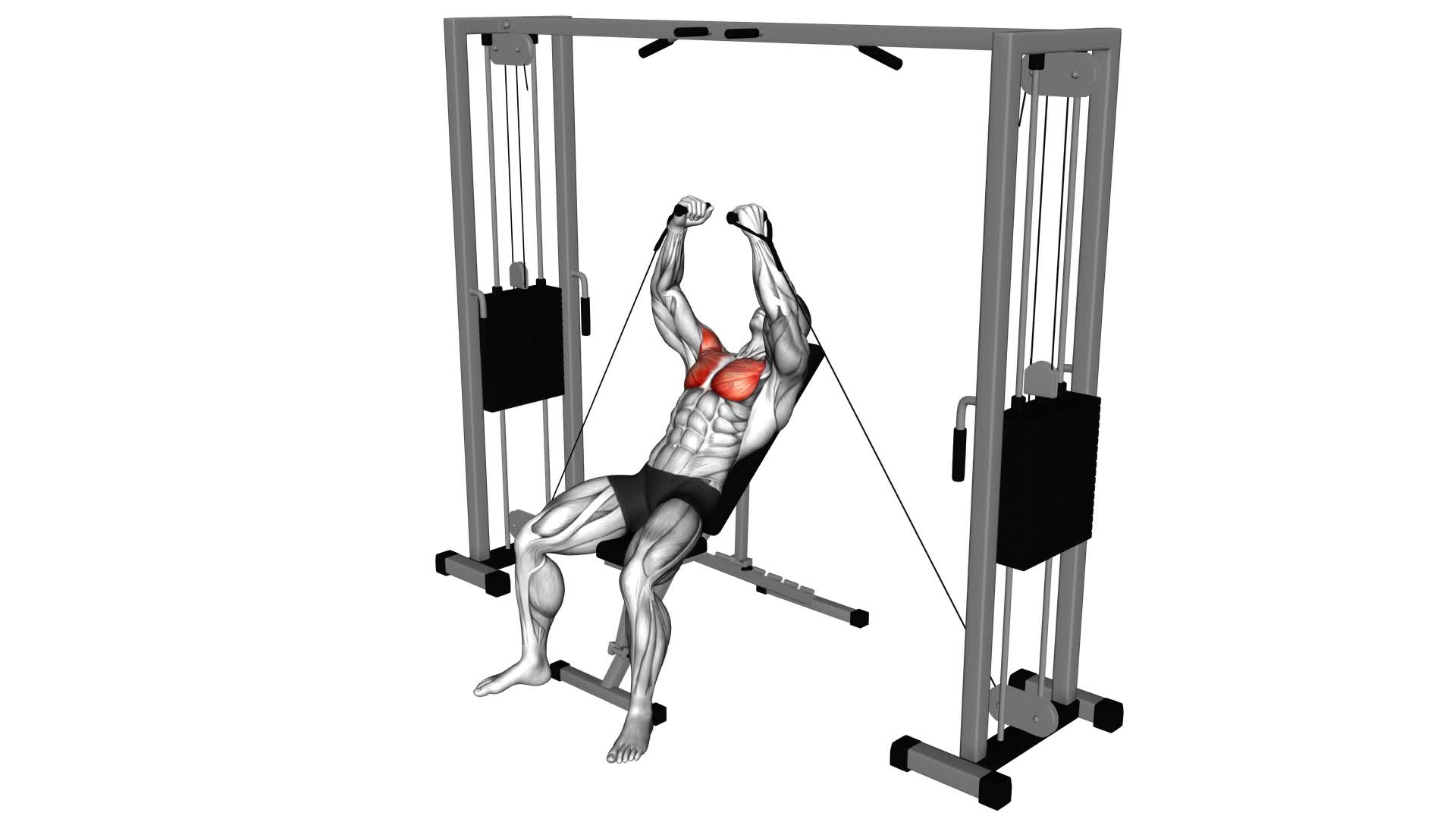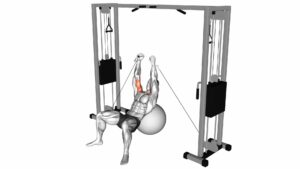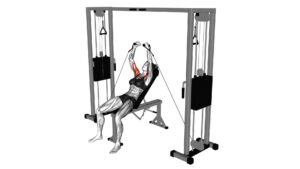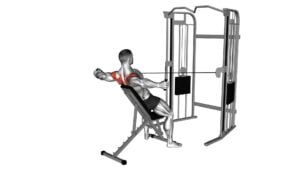Cable Incline Fly – Video Exercise Guide & Tips

Are you looking to improve your upper body strength and sculpt your chest muscles? Look no further than the cable incline fly exercise!
Watch This Exercise Video
In this video exercise guide, we'll show you the proper technique, equipment setup, and variations for the cable incline fly.
Plus, we'll share common mistakes to avoid and tips for maximizing your results.
Get ready to take your chest workout to the next level with this effective and engaging exercise.
Let's get started!
Key Takeaways
- Adjust the cable machine for full arm extension and use a slight bend in the elbows throughout the exercise.
- Avoid using too much weight to maintain proper form and prevent injury.
- The cable incline fly engages the chest muscles, shoulders, and upper back, improving posture and strength.
- Modify the exercise by changing the grip, incorporating alternative exercises, and using variations like the dumbbell incline fly and push-ups.
Proper Technique for Cable Incline Fly
To perform the Cable Incline Fly exercise properly, start by adjusting the cable machine to a height that allows your arms to fully extend when reaching overhead. This is important because it ensures that you're able to achieve the full range of motion and target the muscles effectively.
Once the machine is adjusted, stand facing away from the machine and grasp the handles with an overhand grip. Step forward, positioning one foot in front of the other for stability. Keep your core engaged and maintain a slight bend in your elbows throughout the exercise.
One common error to watch out for is using too much weight. It's important to start with a lighter weight and gradually increase as you become more comfortable with the movement. Using too much weight can lead to improper form and potential injury.
The Cable Incline Fly offers several benefits. Firstly, it targets the chest muscles, specifically the pectoralis major and minor. It also engages the muscles in your shoulders and upper back, helping to improve posture and overall upper body strength. Additionally, this exercise can enhance stability and coordination, as it requires balance and control throughout the movement.
Equipment and Setup for Cable Incline Fly
For the Cable Incline Fly exercise, you'll need to set up the cable machine and adjust it to the appropriate height. Here are three steps to help you with the equipment and setup for the Cable Incline Fly:
- Position the cable incline fly machine: Find a cable incline fly machine in your gym. Ensure that the machine is positioned at an incline angle of around 45 degrees. This angle will target your upper chest muscles effectively.
- Adjust the cable height: Locate the adjustable pulleys on the machine and set them to a height that aligns with your shoulders or slightly above. This height will allow you to perform the exercise with proper form and range of motion.
- Attach the handles: The cable incline fly machine usually comes with handles or stirrup attachments. Attach the handles to the cables, ensuring that they're secure and won't slip during the exercise.
Variations and Modifications for Cable Incline Fly
Adjusting the cable height and positioning the machine at the appropriate incline angle will allow you to explore various variations and modifications for the Cable Incline Fly exercise. One way to modify this exercise is by changing your grip. Instead of using a standard grip, you can try a wide grip or a narrow grip. A wide grip will target your outer chest muscles, while a narrow grip will focus more on your inner chest muscles. By experimenting with different grip options, you can effectively target different areas of your chest and add variety to your workout routine.
In addition to modifying your grip, there are also alternative exercises that you can incorporate to work your chest muscles differently. One alternative exercise is the Dumbbell Incline Fly. This exercise requires dumbbells instead of cables and allows for a greater range of motion. Another alternative exercise is the Push-Up. This classic exercise not only targets your chest muscles but also engages your core and upper body. You can modify the intensity of the Push-Up by performing it on an incline or decline surface.
Common Mistakes to Avoid During Cable Incline Fly
When performing the Cable Incline Fly, it's important to be aware of common mistakes that can hinder your progress and potentially lead to injury. Here are three common mistakes to avoid and some tips for form correction:
- Using too much weight: One of the most common mistakes during the Cable Incline Fly is using too much weight. This can compromise your form and put unnecessary strain on your shoulders and chest. To correct this, start with a lighter weight and focus on proper form before gradually increasing the resistance.
- Rounded shoulders: Another common mistake is allowing your shoulders to round forward during the exercise. This not only reduces the effectiveness of the movement but also increases the risk of shoulder injury. To correct this, consciously retract your shoulder blades and maintain a tall posture throughout the exercise.
- Flaring elbows: Flaring your elbows out to the sides is a mistake that can put excessive stress on your shoulder joints. To avoid this, keep your elbows slightly bent and maintain a controlled and stable movement throughout the exercise.
Tips for Maximizing Results With Cable Incline Fly
To maximize your results with the Cable Incline Fly, focus on maintaining proper form and gradually increasing the resistance over time. This exercise is known for its effectiveness in chest workouts and building upper body strength.
To ensure you get the most out of your workout, here are some tips:
- Start with a suitable weight: Begin with a weight that challenges you but still allows you to perform the exercise with proper form. As you progress, gradually increase the resistance to continue challenging your muscles.
- Keep your back and shoulders stable: Maintain a stable position throughout the exercise by retracting your shoulder blades and keeping your back flat against the bench. This will help engage your chest muscles more effectively.
- Control the movement: Focus on controlling the cables and avoid using momentum. Slowly bring your hands together in front of your chest and then return to the starting position. This will maximize the tension on your chest muscles and ensure a more effective workout.
- Use a full range of motion: Extend your arms fully while bringing the cables together and feel the stretch in your chest. This will help engage your chest muscles throughout the entire exercise.
Frequently Asked Questions
How Many Sets and Reps Should I Do for the Cable Incline Fly Exercise?
To get the most out of the cable incline fly exercise, it's important to know how many sets and reps to do. Without the context of the Cable Incline Fly – Video Exercise Guide & Tips, I can tell you that the number of sets and reps will depend on your fitness goals and current level of strength.
It's always a good idea to start with lighter weights and gradually increase as you get more comfortable with the proper form. Alternatives to this exercise include dumbbell flyes or chest presses.
Can I Use Dumbbells Instead of a Cable Machine for the Cable Incline Fly?
Yes, you can definitely use dumbbells instead of a cable machine for the cable incline fly exercise. This variation can offer similar benefits for chest development.
By using dumbbells, you can still target the pectoral muscles effectively while engaging your stabilizer muscles.
It's important to maintain proper form and control throughout the movement.
Incorporating dumbbells into your routine can add variety and challenge to your chest workouts.
What Muscles Does the Cable Incline Fly Target?
The cable incline fly is a great exercise for targeting multiple muscles. It primarily works your chest muscles, specifically the pectoralis major and minor. By using the cable machine, you can also engage your shoulders and triceps to a greater extent compared to using dumbbells.
Incorporating cable exercises in your workout routine provides additional resistance and stability, allowing for greater muscle activation and growth. There are variations of the incline fly exercise that can target different muscles, such as using different angles or hand positions.
Is It Necessary to Warm up Before Performing the Cable Incline Fly?
Before performing the cable incline fly, it's highly recommended that you warm up. Warming up before any workout has several benefits, such as increasing blood flow to your muscles, improving flexibility, and reducing the risk of injury.
Additionally, incorporating different variations of the incline fly exercise can target specific muscle groups, helping you achieve your fitness goals more effectively.
Can Beginners Perform the Cable Incline Fly Exercise?
Yes, beginners can definitely perform the cable incline fly exercise. It's a great way for beginners to strengthen their chest muscles and improve their upper body strength.
The cable incline fly targets the pectoral muscles, shoulders, and triceps, helping to create a well-rounded upper body.
However, it's important for beginners to start with lighter weights and focus on proper form to avoid common mistakes such as using too much weight or rounding the shoulders.
Conclusion
In conclusion, incorporating cable incline fly into your workout routine can help target and strengthen your upper chest muscles. By using proper technique and avoiding common mistakes, you can maximize the results of this exercise.
Remember to adjust the equipment and setup to suit your needs, and feel free to explore variations and modifications to keep your workouts challenging and effective.
Get ready to achieve a stronger, more defined upper chest with cable incline fly.

Author
Years ago, the spark of my life’s passion ignited in my mind the moment I stepped into the local gym for the first time. The inaugural bead of perspiration, the initial endeavor, the very first surge of endorphins, and a sense of pride that washed over me post-workout marked the beginning of my deep-seated interest in strength sports, fitness, and sports nutrition. This very curiosity blossomed rapidly into a profound fascination, propelling me to earn a Master’s degree in Physical Education from the Academy of Physical Education in Krakow, followed by a Sports Manager diploma from the Jagiellonian University. My journey of growth led me to gain more specialized qualifications, such as being a certified personal trainer with a focus on sports dietetics, a lifeguard, and an instructor for wellness and corrective gymnastics. Theoretical knowledge paired seamlessly with practical experience, reinforcing my belief that the transformation of individuals under my guidance was also a reflection of my personal growth. This belief holds true even today. Each day, I strive to push the boundaries and explore new realms. These realms gently elevate me to greater heights. The unique combination of passion for my field and the continuous quest for growth fuels my drive to break new ground.







